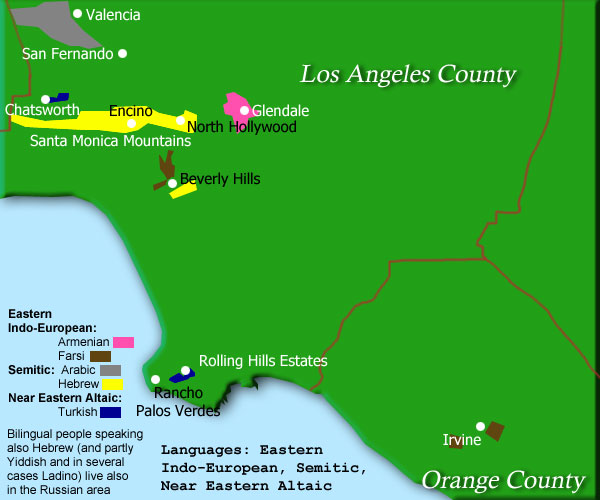
The Iranian Community
Compiled by Clifton L. Holland
Tehrangeles: L.A. the Iranian expatriate capital abroad
By Heather Catherine Orr | RAW STORY COLUMNIST
California has one of the largest Iranian populations of the Iranian Diaspora, estimated at 300,000 to 600,000, and most of these exiles from the 1979 Islamic revolution reside in Los Angeles and Southern California. In fact, the population has grown so dramatically since the 1970s and ’80s that to some, Los Angeles is known as Tehrangeles or even Irangeles.
“Like Tehran, L.A. is a mountain-ringed, traffic-plagued, smog-filled bowl, where Iranian retirees putter in gardens and wait at bus stops,” says Tara Bahrampour in the November 2003 New Yorker article, “Persia on the Pacific.”
“And to some extent they are all elite,” Bahrampour adds. “In Iran, they were not maids or shepherds but people who had enough sophistication and cash to get to America.”
As a result of the large, well-educated and successful Iranian immigrant community, Los Angeles boasts 10 Iranian newspapers; numerous Iranian-owned stores, restaurants and other businesses; locally produced Iranian television and radio shows; Iranian yellow pages; and the largest Persian bookstore outside of Iran, according to Edmund F. Scherr, a Washington correspondent.
The L.A. County Museum of Art’s recent acquisition of 775 objects now makes it one of the world’s 10 best places to see historic Islamic art.
Although Iranians are commonly thought of as mainly Muslims, there are populations of Jews, Bahai’s, Armenian and Nestorian (Assyrian) Christians, Zoroastrians and various Sufi orders of Iranians in Los Angeles. But despite the advantages Iranian immigrants enjoy because of their large numbers in Los Angeles, the Iranian-American communities overall comprise fewer than a million Iranian immigrants and so they do not enjoy the benefits given to other bigger and more recognizable ethnic communities.
But according to the fact sheet on the Iranian-American Community by Ali Mostashari for the Iranian Studies Group Research Series of February 2004, the 2000 Census reports that Iranians are well-educated and have six times as many doctoral degrees as Americans on average. The 2000 Census also shows Iranian-Americans as having a 45 percent higher per capita income and a median family income 38 percent higher than the national average.
Iranian immigrants might enjoy more benefits in Los Angeles than in the rest of the country, but these do not keep them completely insulated from the hardships of being part of an often ignored and misunderstood ethnic community. Bahrampour comments that “Andre Dubus III’s novel “The House of Sand and Fog,” in which a former Iranian colonel puts on a suit every morning and then changes clothes on the way to his job as a trash collector on a California highway,” illustrates the disconnection some Iranian-Americans feel to their adopted homeland.
“For all the successful Iranian entrepreneurs, there are men of a certain age who, paralyzed by the loss of their former status, came here and refused to learn English or to get driver’s licenses.” And at the end of 2002, U.S. immigration officials in Southern California detained hundreds of Iranians and other Muslim men who turned up to register under residence laws brought in as part of an anti-terror drive. The community was outraged because “several hundred L.A. Iranians, including many Jews, were detained on visa violations. Most were eventually released, but in a rare show of unity thousands of Iranians marched down Wilshire Boulevard in protest,” Bahrampour report, adding, “The thought that they had anything to do with Osama bin Laden was, to them, an absurdity.”
After the shah’s death in 1980, the restrictions placed on Iranian exiles who wished to return to Iran were somewhat relaxed, and those who felt homesick began to cautiously return, although their living situation in Iran remains precarious. On the other hand, despite the drawbacks many have found living abroad favorable over going back to an Iran still ruled by a mostly restrictive Islamic government. But change is inevitable because now, “Young people … make up more than half of the country’s population and as they come of age, they will gain leverage against the Islamic rule imposed by the older clerics,” notes Bahrampour, “And chances are Iran will become, in certain ways, more like L.A,” as young Iranians seek to mirror the lifestyles of their fellow expatriates.
SOURCE: http://rawstory.com/exclusives/orr/tehrangeles_iran_capital_expatriates_812.htm
Eastern
Indo-European, Semitic,
Near Eastern Altaic languages
Spoken in the Los Angeles Area

SOURCE: http://www.humnet.ucla.edu/flr/media/LAmap/lamapNEASIA.htm
Bibliography
Farsi (Persian) in Los Angeles: http://www.humnet.ucla.edu/languagesofla/farsi/farsi.htm
Irangeles: Iranians in Los Angeles by Ron Kelley, Jonathan
Friedlander and Anita Colby (editors):
http://www.amazon.com/Irangeles-Iranians-Angeles-Ron-Kelley/dp/0520080092
Irangeles: Iranians in Los Angeles: http://www.international.ucla.edu/cnes/publications/article.asp?parentid=14556